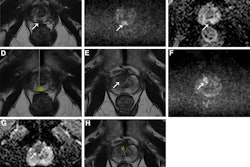A deep-learning model based on MRI and clinical parameters appears effective for predicting the risk of prostate cancer progression, according to a study published January 10 in Radiology: Imaging Cancer.
The findings could translate to a reduction in unnecessary biopsies, wrote a team led by Christian Roest of University Medical Center Groningen in the Netherlands.
"Our proposed method could help to reduce the overuse of biopsies and MRI by guiding follow-up frequency in low-risk prostate cancer surveillance," it noted.
Prostate cancer is the most common cancer among men, and the incidence of low-risk disease is high -- which makes active surveillance an increasingly attractive strategy, the investigators explained. Risk calculators play an important role in managing prostate cancer, and there are a number that are currently used, but those currently available have "limited reliability because of their dependence on clinical variables with high variability," they wrote.
That's why deep learning based on MRI features could help, according to Roest's group.
"Deep-learning models based on MRI features have the potential to enhance follow-up strategies by training them to capture patterns relevant to the risk of progression, and these models may offer more precise, patient-specific risk estimates for disease progression," the authors noted.
Roest and colleagues conducted a study that included 1,607 MRI scans from 1,143 male patients who underwent the exams due to a suspicion of clinically significant prostate cancer between January 2012 and May 2022 but who were negative for the disease at baseline MR imaging. The investigators developed a deep-learning model that incorporated data from these baseline exams and information from clinical parameters (i.e., age, prostate-specific antigen [PSA] level, PSA density, and prostate volume) to predict time to prostate cancer progression (which they defined as diagnosis of clinically significant disease at follow-up).
Using the Harrell C-index (which uses 1 as reference of best model prediction), they compared the performance of the model up to five years after baseline MRI with the following risk calculators: the European Randomized Study of Screening for Prostate Cancer (ERSPC) future-risk calculator; the Prostate Cancer Prevention Trial (PCPT) risk calculator; and the Prostate Imaging Reporting and Data System (PI-RADS). The scans came from an internal cohort (Radboud University Medical Center) and an external cohort (Netherlands Cancer Institute).
The team found the following:
- The deep-learning model predicted clinically significant prostate cancer progression with a hazard ratio [HR] for the internal cohort of 1.97 and for the external cohort of 1.32.
- The model identified a subgroup of patients (approximately 20%) with risk of clinically significant prostate cancer of 3% or less, 8% or less, and 18% or less after 1-, 2-, and 4-year follow-up.
- The model had a C-index of 0.68 for the internal cohort and 0.56 for the external group, outperforming ERSPC and PCPT (both p < 0.001) in the internal group.
The findings are promising, according to the authors.
"Our [deep-learning] model showed robust prognostic value across internal and external cohorts … [which] suggests that DL-based risk estimates could enhance the robustness of risk assessments across health care centers compared with existing tools," they concluded.
The complete study can be found here.


.fFmgij6Hin.png?auto=compress%2Cformat&fit=crop&h=100&q=70&w=100)





.fFmgij6Hin.png?auto=compress%2Cformat&fit=crop&h=167&q=70&w=250)











